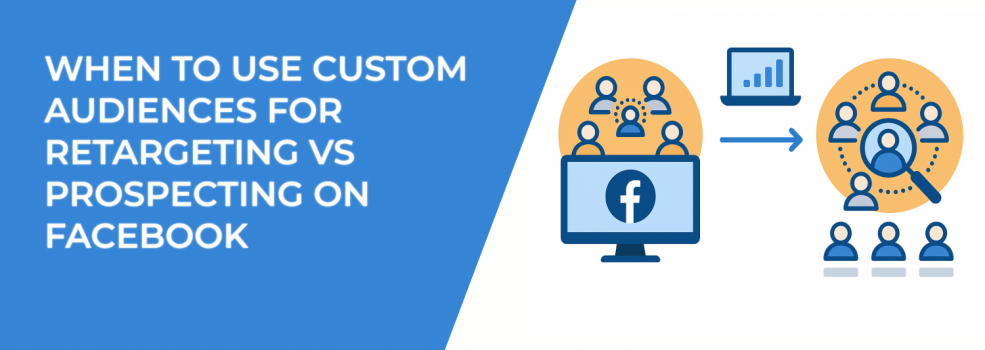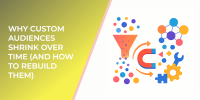Facebook advertising has become more data-driven than ever — but smart targeting still separates the winners from the waste. And few targeting tools are more powerful than Custom Audiences.
They allow you to reach users based on real actions they've taken: visiting your site, engaging with content, signing up for your emails, or even purchasing. But knowing when to use these audiences for retargeting versus prospecting is where the real performance gains happen.
Let’s explore what Custom Audiences are, when to use them for each objective, and how to avoid common mistakes that lead to wasted ad spend.
What Are Facebook Custom Audiences?
Custom Audiences are Facebook’s way of helping advertisers reconnect with users who’ve already interacted with their brand. These interactions could come from your website, mobile app, CRM, or Facebook and Instagram engagement.
You can build a Custom Audience using data from:
-
Website activity, tracked via the Meta Pixel or Conversions API;
-
Customer files, like email or phone number lists;
-
App interactions, such as installs or in-app purchases;
-
Offline data, including purchases made in-store or over the phone;
-
Facebook or Instagram engagement, like post interactions or video views.
Because these audiences are based on real behavior, they’re far more precise than interest-based targeting alone — and they can be used in two distinct ways: to retarget warm audiences or to prospect new ones via Lookalike Audiences.
If you're new to audience strategy or want to refine your approach, start with this guide to Facebook Ad Targeting 101 for a foundational understanding of targeting layers.
When to Use Custom Audiences for Retargeting
Retargeting is all about turning interest into action. When someone visits your product page, adds an item to cart, or watches your video, they’re expressing intent — even if they don’t convert on the spot.
This is where Custom Audiences are essential. You can re-engage these users with messaging that picks up where their journey left off. You’re not introducing your brand — you’re nudging someone who already knows you.
Here’s when Custom Audiences are ideal for retargeting:
1. Website Visitors
Target users who visited your site in the last 7–30 days. You can narrow this by page type (product pages, pricing pages, blog posts) to customize your messaging based on user intent.
2. Cart or Checkout Abandoners
These are high-value prospects. They got close to buying but didn’t finish. Retarget them with product reminders, reviews, limited-time offers, or free shipping incentives.
3. Engaged Video Viewers
Users who watched 50% or more of your video content are showing strong interest. Follow up with testimonial videos, deeper product demos, or direct call-to-action offers.
4. Facebook and Instagram Engagers
Target people who have liked, commented, saved, or messaged your brand. These are warm leads who’ve already interacted with your social presence.
But don’t just create retargeting audiences and hope for the best. You should segment by funnel stage, update your audiences frequently, and limit ad frequency to avoid burnout. Excluding past purchasers is also critical to reduce wasted impressions — and you can learn more about that in this guide to Facebook exclude targeting.
If your ads aren’t delivering, over-targeting could be the issue. Here’s why your ad set may get zero reach — and how to fix it.
Remember, retargeting works best when the messaging feels like a continuation — not a repeat — of the user’s last touchpoint.
When to Use Custom Audiences for Prospecting
Many advertisers overlook the role Custom Audiences play in top-of-funnel campaigns. But they’re foundational to one of Facebook’s best prospecting tools: Lookalike Audiences.
Lookalike Audiences allow you to find new people who are similar to a source Custom Audience — whether that’s your best customers, highest-spending subscribers, or most engaged app users. This is cold traffic, but with higher built-in intent.
Use Custom Audiences for prospecting when:
-
You have a strong, high-value customer base to model from.
-
Your current cold targeting performance is declining.
-
You’re trying to scale efficiently without losing quality.
-
You’re entering a new market or launching a new product.
Choosing the Right Source Audience
Not all seed audiences are created equal. You’ll get the best results when you build Lookalikes from your:
-
Top 5–10% of customers by lifetime value (LTV);
-
Recent purchasers with strong AOV;
-
Repeat buyers or subscribers with high engagement;
-
Active email list subscribers or webinar attendees.
For a deeper comparison between the two core audience types, this breakdown of Custom vs Lookalike Audiences will help you choose the right strategy based on your goals.
To start, create 1% Lookalikes for highest accuracy. Then, expand to 2–5% for scale. Always exclude your original Custom Audience from the Lookalike campaign to avoid unnecessary overlap — a common performance killer. You can learn more about this in The Role of Audience Overlap in Facebook Ads.
Lookalikes are not a silver bullet — they require testing, exclusions, and continual refinement. But when built from well-curated Custom Audiences, they can become your most consistent cold traffic performers.
Retargeting vs Prospecting: Which One Comes First?
If you’re wondering whether to start with prospecting or retargeting, the answer depends on your business stage and data volume.
If you’re a new brand with minimal traffic, prospecting is your priority. You need to bring users into the funnel using Lookalikes or interest targeting. Without any audience data, there’s nothing to retarget.
If you already have site visitors, leads, or social engagement, then retargeting becomes essential. It’s often cheaper and more efficient to convert someone who already knows your brand than to acquire someone new.
The most effective campaigns don’t choose between retargeting or prospecting — they do both. You build cold traffic through Lookalikes, capture engagement, and then retarget based on funnel activity.
Think of it as a loop:
-
Top of Funnel: Prospecting with Lookalikes.
-
Middle of Funnel: Re-engagement using page views, video views, or social engagement.
-
Bottom of Funnel: Conversion-focused retargeting for cart abandoners or lead form starters.
Need help balancing your strategy? This breakdown of retargeting vs broad targeting explains when each method shines.
Final Thoughts
Custom Audiences should never be an afterthought. They’re the core of a responsive, data-driven ad strategy on Facebook.
Used properly, they allow you to:
-
Capture more value from existing traffic.
-
Re-engage users who already know your brand.
-
Scale campaigns by modeling your best customers.
-
Segment audiences for more personalized messaging.
-
Improve efficiency by reducing wasted impressions.
But misuse them — or rely on outdated lists, unrefined seeds, or over-targeting — and they can drag your results down.
Custom Audiences aren’t just for retargeting. And Lookalikes aren’t just for scaling. Together, they create a system that drives performance at every stage of your funnel.

